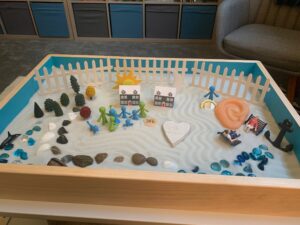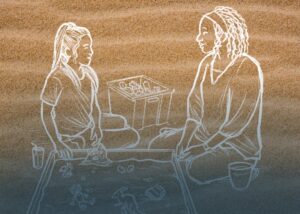If you’re looking for a unique and engaging way to address mental health issues, look no further than sand tray therapy. This therapy modality has been shown to be particularly effective in helping children and adolescents work through their problems. In this blog post, we will discuss the basics of sand tray therapy, including what it is and how it works. We will also talk about the benefits of this approach and provide some tips for getting started.
Contents
Defining Sand Tray Therapy
Sand tray therapy is a form of expressive therapy that uses sand and miniature toys to help individuals work through their emotions and experiences. This type of therapy can be used with people of all ages, but it is often used with children and adolescents.
This is a relatively new therapy modality, but it has already shown to be quite effective across different age groups for a variety of conditions. It also has a low rate of dropout, which is often an issue with other types of therapy.
It is important to note that sand tray therapy is not play therapy. Play therapy is a type of therapy that uses play to help children work through their emotions. While sand tray therapy does use some elements of play, it is not the same as play therapy.
How It Works

The therapist will start by providing the client with a tray of sand and a selection of miniature toys. The client is then free to choose which toys they would like to use and how they would like to arrange them in the sand. There is no right or wrong way to do this, and the therapist will not judge the client’s choices. This scene can represent anything that is on the client’s mind, such as their home life, family, friends, or school.
After the client has had a chance to play with the sand and toys, the therapist will help the client to interpret what they have made. This interpretation can provide insight into the client’s thoughts and feelings. They will also be asked to talk about their experience. The therapist will encourage the client to talk about their feelings and what the sand and toys represent for them. This process can help the client to work through their emotions and gain insight into their experiences.
The therapist may also use other techniques, such as art therapy or talk therapy, in conjunction with sand tray therapy. This can help to further engage the client and provide additional insights.
Benefits
There are many benefits of sand tray therapy. This type of therapy can help children and adolescents to express themselves in a safe and non-threatening environment. It can also be used to address a variety of mental health issues, such as:

- Anxiety
- Depression
- Attention Deficit Hyperactivity Disorder (ADHD)
- Autism
- Learning disabilities
- Problems with communication
- Interpersonal difficulties
- Unresolved trauma or abuse
- Developmental issues
- Post Traumatic Stress Disorder (PTSD)
- Self-esteem issues
- Problems with work/school performance
- Anger management
- Grief
This type of therapy can also be used to help people of all ages to work through their emotions and gain insight into their experiences. It is a unique and engaging way to address mental health issues.
This approach is also beneficial because it is engaging and fun. This can help to keep clients engaged in the therapeutic process. It is also a low-cost therapy modality that does not require any specialized equipment.
Drawbacks
There are some drawbacks to sand tray therapy.
- This type of therapy can be time-consuming, and it may require multiple sessions to see results. It is also important to find a therapist who is trained in this modality.
- It may also not be suitable for everyone, and it may not be appropriate for certain mental health issues.
- This type of therapy can be messy, and it may not be suitable for everyone. This is so because of the nature of the therapy.
- Another drawback is that it may not be covered by insurance.
Lastly, it is important to find a therapist who is trained in this type of therapy. This can be difficult as it is a relatively new therapy modality.
Tips for Getting Started

If you are interested in sand tray therapy, there are a few things you can do to get started.
First, you need to find a therapist who is trained in this type of therapy. You can ask your doctor for a referral or look for a therapist online. Before booking an appointment, you may schedule for a consultation. During this process, you can ask your potential therapist any questions you may have. Some examples can include:
- What is your experience with sand tray therapy?
- Do you have any specialized training in this type of therapy?
- What are your rates?
- Do you take insurance?
- How long will each session last?
You should also ask about the therapist’s cancellation policy. This is important as you may need to cancel or reschedule appointments from time to time.
Once you have found a therapist, you can schedule an appointment and begin the process of sand tray therapy. During your first session, the therapist will likely ask you questions about your goals for therapy and what you hope to achieve. They will also explain how sand tray therapy works and what you can expect during each session. After that, they will help you to select the sand and toys that you will use.
Sand tray therapy is a unique and engaging way to address mental health issues. It can be used to help children and adolescents to express themselves in a safe and non-threatening environment. It can also be used to help people of all ages to work through their emotions and gain insight into their experiences. This type of therapy can be beneficial for many people, but it is important to keep in mind that it may not be suitable for everyone.
Things To Consider
If you are considering sand tray therapy, there are a few aspects you may want to look after. These include:
- Finding a therapist trained in sand tray therapy
- Making sure that this type of therapy would be suitable for you
- Considering the time and effort required for each session
- Determining if your insurance policy covers this type of therapy
Sand tray therapy can be a beneficial form of treatment for many people. It is important to keep in mind, however, that it may not be the right fit for everyone. If you are considering this type of therapy, make sure to do your research and ask any necessary questions before getting started.
Conclusion
Conclusively, we now know that sand tray therapy is a new and dynamic approach to mental health that can be used to help children and adults alike. Although it is not suitable for everyone, sand tray therapy may be a good fit for you if you are looking for an engaging and unique way to address your mental health goals.
If you have any further questions about sand tray therapy or would like to find a therapist trained in this type of therapy, please contact Mantra Care. We have a team of expert mental health professionals offering a variety of therapies catering to a variety of issues. Our services are available globally at pocket-friendly rates with maximum confidentiality. You may visit our website to book a session or download our free Android or iOS app for more information!


